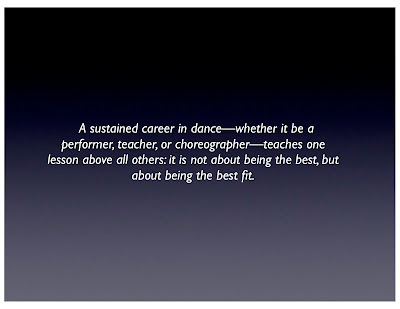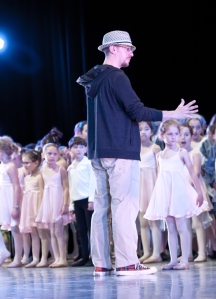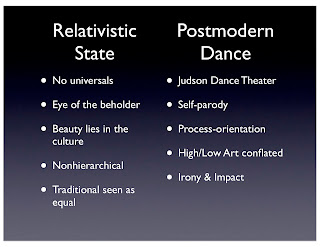Dance Paradigms (Part 1)
This past October I presented my paper, Dance Movements: From Traditionalism to Postmodernism and Beyond, at the National Dance Education Organization annual conference in Minneapolis. I am excited by the conversations that it sparked and have been thinking of different ways to share the information so that more discussion and feedback could be generated. I am going to try to include it on this blog as a series of posts.
So, consider this post number one--the introduction. I should start by explaining that this whole inquiry began with a lesson I learned long ago: a sustained career in dance—whether it be a performer, teacher, or choreographer—is not about being the best, but about being the best fit.
I do not simply refer to the cliché where the dancer who gets the job is the one who happens to fit the costumes of the person who they are replacing, although that does apply. Instead, I refer to the idea that there is not one ‘best’ dancer, teacher, or choreographer. There are only better and worse fits for any situation. I learned this the hard way while teaching at a recreational dance studio in Long Island.
I took this teaching job to supplement my income while I was dancing with the Metropolitan Opera Ballet. Prior to this point, I had great success as a teacher. Although I was young (or perhaps because of it), I could reach my students and they responded well to my lessons. However, I learned that I did not have the magic touch in all situations.
My drive and encouragement did not lead to progress at this particular recreational studio. The seriousness of purpose with which I approached my teaching failed to resonate with the studio owner and her students. Their motivations were to have fun and find belonging within the group.
I came from a recreational studio myself but then learned the dedication and knowledge necessary to transition into a professional career in my college training. As a teacher, my strength had been reaching recreational students, much like I had been, and giving them the knowledge and information to take the same leap I had. However, in this case, I pushed too hard and no one was interested in making that leap.
The owner eventually fired me after I verbalized my frustration about the students’ lack of hard work. She was right to do so, not just because I told them they were being lazy, but also because I was never the best fit for that situation in the first place.
It was then that I started to realize that there were different approaches to take in different situations. My one-size-fits-all approach to dance education proved flawed. Luckily, I learned from this and went on to find situations that were better fits.
However, just finding the best fit was not the end of the lesson. As a teacher, I wanted to understand my students so that I could do the best for all of them—not just the ones who aligned with my own values. In reading books on psychology and philosophy, I came upon professor Clare Graves Emergent, Cyclical Levels of Human Existence. In his system I could see, for the first time, the motivations and psychology behind the various situations I had encountered.
Furthermore, the conceptual theory of developmental psychology that Graves proposes holds promise not just for individuals, but also for whole systems. He applied his work as an organizational psychologist in addition to working with individuals. What strikes my particular interest at this time is the parallel running between the developmental stages Graves uncovered in his research and the artistic movements of our past and present.
In my undergraduate dance studies, the motivations behind classical, modern, and postmodern dance were left unclear. My classmates and I could point them out when seeing them and classify them appropriately, but the thinking behind them was never fully elucidated. We all could tell you which we preferred to watch and perform, but I suspect few of us really grasped what motivations were behind them other than the simplistic platitudes we regurgitated like “modern dance was a rebellion against the rigid structure of classical ballet.”
For the purposes of this series of posts, I plan to investigate the parallels between Graves’ framework and the development of dance from traditional to classical to modern to postmodern and beyond. From this process, I hope to gain a better understanding of this development and each of the paradigms so that I can become a more informed, more insightful artist and teacher.
I believe this information has the potential to build a bridge in understanding between dance and the art movements of the past, present, and future for both young and ‘not so young’ dance artists. While the scope of these posts will be the historical scale, I will also include personal and organizational examples for each movement.
But first, I have to admit to an underpinning philosophy that is at the foundation of this exploration. That is, as Keith Martin-Smith states in his essay On the Future of Art and Art Criticism, “A truism: Art reflects the culture and the worldview of the person who makes it.” Ideology and form are intertwined--whether consciously or unconsciously. Embracing the connection of ideology and form as a forgone conclusion, the next step is to introduce Graves’ framework...
So, consider this post number one--the introduction. I should start by explaining that this whole inquiry began with a lesson I learned long ago: a sustained career in dance—whether it be a performer, teacher, or choreographer—is not about being the best, but about being the best fit.
I do not simply refer to the cliché where the dancer who gets the job is the one who happens to fit the costumes of the person who they are replacing, although that does apply. Instead, I refer to the idea that there is not one ‘best’ dancer, teacher, or choreographer. There are only better and worse fits for any situation. I learned this the hard way while teaching at a recreational dance studio in Long Island.
I took this teaching job to supplement my income while I was dancing with the Metropolitan Opera Ballet. Prior to this point, I had great success as a teacher. Although I was young (or perhaps because of it), I could reach my students and they responded well to my lessons. However, I learned that I did not have the magic touch in all situations.
My drive and encouragement did not lead to progress at this particular recreational studio. The seriousness of purpose with which I approached my teaching failed to resonate with the studio owner and her students. Their motivations were to have fun and find belonging within the group.
I came from a recreational studio myself but then learned the dedication and knowledge necessary to transition into a professional career in my college training. As a teacher, my strength had been reaching recreational students, much like I had been, and giving them the knowledge and information to take the same leap I had. However, in this case, I pushed too hard and no one was interested in making that leap.
The owner eventually fired me after I verbalized my frustration about the students’ lack of hard work. She was right to do so, not just because I told them they were being lazy, but also because I was never the best fit for that situation in the first place.
It was then that I started to realize that there were different approaches to take in different situations. My one-size-fits-all approach to dance education proved flawed. Luckily, I learned from this and went on to find situations that were better fits.
However, just finding the best fit was not the end of the lesson. As a teacher, I wanted to understand my students so that I could do the best for all of them—not just the ones who aligned with my own values. In reading books on psychology and philosophy, I came upon professor Clare Graves Emergent, Cyclical Levels of Human Existence. In his system I could see, for the first time, the motivations and psychology behind the various situations I had encountered.
Furthermore, the conceptual theory of developmental psychology that Graves proposes holds promise not just for individuals, but also for whole systems. He applied his work as an organizational psychologist in addition to working with individuals. What strikes my particular interest at this time is the parallel running between the developmental stages Graves uncovered in his research and the artistic movements of our past and present.
In my undergraduate dance studies, the motivations behind classical, modern, and postmodern dance were left unclear. My classmates and I could point them out when seeing them and classify them appropriately, but the thinking behind them was never fully elucidated. We all could tell you which we preferred to watch and perform, but I suspect few of us really grasped what motivations were behind them other than the simplistic platitudes we regurgitated like “modern dance was a rebellion against the rigid structure of classical ballet.”
For the purposes of this series of posts, I plan to investigate the parallels between Graves’ framework and the development of dance from traditional to classical to modern to postmodern and beyond. From this process, I hope to gain a better understanding of this development and each of the paradigms so that I can become a more informed, more insightful artist and teacher.
I believe this information has the potential to build a bridge in understanding between dance and the art movements of the past, present, and future for both young and ‘not so young’ dance artists. While the scope of these posts will be the historical scale, I will also include personal and organizational examples for each movement.
But first, I have to admit to an underpinning philosophy that is at the foundation of this exploration. That is, as Keith Martin-Smith states in his essay On the Future of Art and Art Criticism, “A truism: Art reflects the culture and the worldview of the person who makes it.” Ideology and form are intertwined--whether consciously or unconsciously. Embracing the connection of ideology and form as a forgone conclusion, the next step is to introduce Graves’ framework...




Comments
Post a Comment